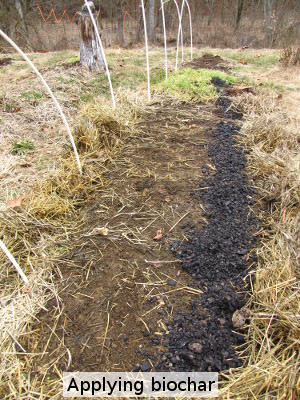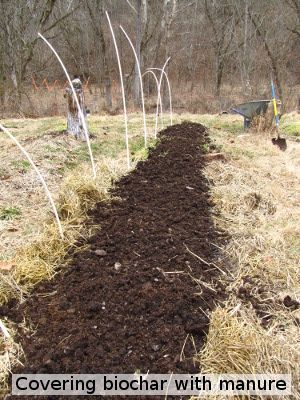
How to apply biochar to your garden
 We started our first biochar
experiment at the beginning of February. After soaking
a bucket of biochar in urine, I applied it in a thin
coating across half of one of our garden beds. (The other half of
the bed was left alone as a control.) Then I added an inch of
well-composted horse manure on top of both halves. I'll be
planting lettuce there this spring, and I hope to be able to see a
difference between the biochar and control portions of the bed.
We started our first biochar
experiment at the beginning of February. After soaking
a bucket of biochar in urine, I applied it in a thin
coating across half of one of our garden beds. (The other half of
the bed was left alone as a control.) Then I added an inch of
well-composted horse manure on top of both halves. I'll be
planting lettuce there this spring, and I hope to be able to see a
difference between the biochar and control portions of the bed.
When applying biochar,
there seems to be only one rule --- make sure the charcoal gets covered
up so it doesn't erode or blow away. Traditional farmers plow
biochar into their soil while no-till farmers have been known to powder
the charcoal and apply it mixed with liquid manures. Although
biochar seems to give the most benefits at or just below the primary
root zone, earthworms and other soil critters have been shown to mix
the biochar into the soil pretty quickly, so you don't need to work too
hard at incorporation.
 Farmers have even applied
biochar to existing perennials (like trees.) One method is to dig
several holes within the tree's root zone, add biochar, then put the
native soil back in. A less intrusive method involves scattering
the biochar on the soil surface in the autumn when the charcoal will
soon be covered up by falling leaves. This last method is
particularly useful in riparian buffers where you need to catch
nutrients leaching away from your field or pasture to prevent pollution
of a stream.
Farmers have even applied
biochar to existing perennials (like trees.) One method is to dig
several holes within the tree's root zone, add biochar, then put the
native soil back in. A less intrusive method involves scattering
the biochar on the soil surface in the autumn when the charcoal will
soon be covered up by falling leaves. This last method is
particularly useful in riparian buffers where you need to catch
nutrients leaching away from your field or pasture to prevent pollution
of a stream.
I have one more bucket
of biochar being activated as I type and suspect I might come up with a
third and final bucket before the heating season is over. I
haven't quite decided what to do with my limited bounty, but am already
thinking of ways to get more biochar. I had originally assumed
that we would make a biochar-producing stove if our garden experiments
look promising, but Mark suggested, instead, hooking up with other wood
burners in our area who are unlikely to use their charcoal.
Turning the region's trash into fertility for our garden seems to be
the theme of 2011!
| This post is part of our Biochar in the Backyard lunchtime series.
Read all of the entries: |
Want more in-depth information? Browse through our books.
Or explore more posts by date or by subject.
About us: Anna Hess and Mark Hamilton spent over a decade living self-sufficiently in the mountains of Virginia before moving north to start over from scratch in the foothills of Ohio. They've experimented with permaculture, no-till gardening, trailersteading, home-based microbusinesses and much more, writing about their adventures in both blogs and books.
Want to be notified when new comments are posted on this page? Click on the RSS button after you add a comment to subscribe to the comment feed, or simply check the box beside "email replies to me" while writing your comment.
